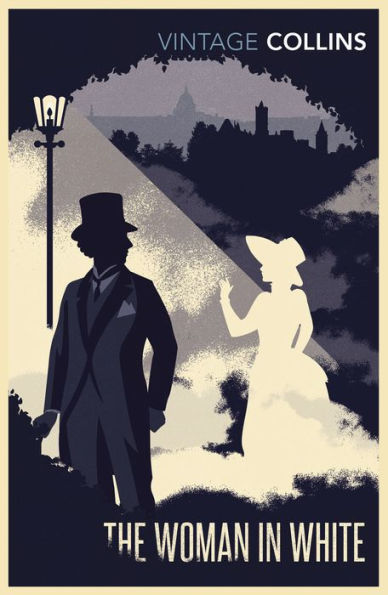Fans of author Ridley Pearson’s bestselling Kingdom Keepers series know that he writes middle grade books filled with adventure, riddles, and breakneck twists and turns. The Initiation, the first novel in his new Lock and Key trilogy, is a fascinating origin story that explores the early lives of Arthur Conan Doyle’s detective Sherlock Holmes and his burgeoning nemesis, James Moriarty, when […]


eBook
Available on Compatible NOOK devices, the free NOOK App and in My Digital Library.
Related collections and offers
Overview

Product Details
| ISBN-13: | 9781407090795 |
|---|---|
| Publisher: | Random House |
| Publication date: | 06/10/2010 |
| Sold by: | Barnes & Noble |
| Format: | eBook |
| Pages: | 624 |
| File size: | 1 MB |
About the Author
Date of Birth:
December 8, 1824Date of Death:
September 23, 1889Place of Birth:
London, EnglandPlace of Death:
London, EnglandEducation:
Studied law at Lincoln¿s Inn, LondonRead an Excerpt
The Woman in White
Table of Contents
List of Illustrations
Acknowledgments
Introduction
William Wilkie Collins: A Brief Chronology
A Note on the Text
The Woman in White
Appendix A: Prefaces to the Novel
1. Preface, 1860, Sampson Low, Son & Co., Three-volume Edition
2. Preface to the Present Edition, 1861, Sampson Low, Son & Co., One-voume Edition
3. Preface. La Femme en Blanc, 1861, trans. E.D. Forgues, J. Hetzel (Paris)
Appendix B: Sample Page from All the Year Round
Appendix C: Commentary and Reviews of The Woman in White
1. The Opinions of Charles Dickens
2. Unsigned Review, Saturday Review (25 August 1860)
3. Unsigned Review [E.S. Dallas], The Times (30 October 1860)
4. "Awful Apparition," Punch (6 April 1861)
5. Unsigned Review [Mrs. Oliphant], Blackwood's Magazine (May 1862)
6. Edmund Yates, "Mr. Wilkie Collins in Gloucester Place," in Celebrities at Home (1879)
7. Wilkie Collins, "How I Write My Books: Related in a Letter to a Friend," The Globe (26 November 1887)
8. F.W. Waddy, "He Wrote 'The Woman in White,'" Once a Week (24 February 1872)
Appendix D: The Woman Question
1. From William Blackstone, Commentaries on the Laws of England (1765-69)
2. From Sarah Stickney Ellis, The Women of England, Their Social Duties, and Domestic Habits (1839)
3. From John Ruskin, Sesame and Lilies, 1865 (1907)
4. From Caroline Norton, A Letter to the Queen (1855)
Appendix E: The Lunacy Panic of 1858 and the Mesmeric Mania of 1851
1. “Lady Bulwer Lytton,” The Times (19 July 1858)
2. “Commission of Lunacy,” The Times (27 July 1858)
3. [Editorial], The Times (28 July 1858)
4. “The Tragedy of Acomb House,” The Sunday Times (1 August 1858)
5. “The Mad-House System,” The Sunday Times (15 August 1858)
6. “Lunatic Asylums and the Lunacy Laws (By a Physician),” The Times (19 August 1858)
7. “Commission in Lunacy,” The Sunday Times (29 August 1858)
8. “Law and Lunacy,” Punch (15 January 1862)
9. “Mesmerism; Its Dangers and Curiosities,” Punch (24 February 1844)
10. Anonymous, “Electro-biology,” Westminster Review (1851)
11. Wilkie Collins, “Magnetic Evenings at Home” (Letter 1), The Leader (17 January 1852)
Select Bibliography
What People are Saying About This
"Collins's mid-Victorian novel is one of the first, and possibly still the greatest, of all literary thrillers." —-The Irish Times
"Collins's mid-Victorian novel is one of the first, and possibly still the greatest, of all literary thrillers." —-The Irish Times
Reading Group Guide
1. Wilkie Collins has been hailed as the creator of the “sensation novel”. Citing examples from The Woman in White, how would you define this Victorian literary genre?
2. In his preface to the 1860 edition of The Woman in White, Collins wrote, “An experiment is attempted in this novel, which has not (so far as I know) been hitherto tried in fiction. The story…is told throughout by the characters of the book.” Was the experiment a success? What is gained and what is lost in telling the story exclusively through first person narratives?
3. In her Introduction to this Modern Library edition, Anne Perry asks, “What is there in The Woman in White that transcends the change in culture from 1860 to the present, and beyond?” How would you answer this question?
4. Collins has been widely praised for his fully drawn portraits. Which characters stand out as the most vivid, and why?
5. Throughout the novel, how does Collins use premonitions, coincidences and dreams to foreshadow key events?
6. “Walter Hartright is very much a man of his time, ” declares Anne Perry. “His view of women is almost unbelievably naïve compared with today’s.” Drawing on Hartright’s descriptions of Marian Halcombe and her sister Laura, as well as Anne Catherick and her mother, do you agree with Perry’s comment? Do you think that Wilkie Collins shared his protagonist’s view of women?
7. Why does Mrs. Catherick allow her own daughter to be placed in an insane asylum, and how does she justify her actions?
8. In his concluding narrative, Count Fosco describes “thefirst and last weakness” of his life. What is the nature of Fosco’s self-described “deplorable and uncharacteristic fault”?
9. Throughout the novel, how does Collins explore the themes of respectability and social class?
